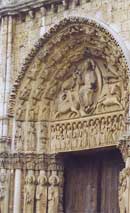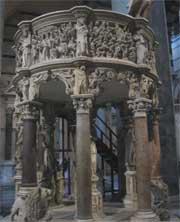Gothic Sculpture
The Gothic sculpture was born as an ornamental function of the Gothic Cathedral, especially the portals. The monumental sculpture progressively detached itself from the architecture. At the beginning of the 13th Century, the Gothic sculpture became independent from the architectural background.

Chartres Cathedral
Western Portal
The 13th Century is the golden epoch of the Gothic Sculpture, artistically, as well as the number of works produced. Speaking of numbers, the southern portals of the Chartres Cathedral boast 783 sculptures.
Gothic Cathedral Sculpture - Chartres Western Portal
The Royal Portal or the Western Portal of the Chartres Cathedral is the most representative work of art to suggest the acquired independence of the Gothic period sculpture. The central theme of the Royal Portal is Christ en Majesté. The entire ensemble is exhibiting more harmony, more grace and elegance than the Romanesque. The central door always bore the name of the "Royal Portal" because it belonged to the celestial majesty of Christ.
The Gothic sculpture above the Western Portal door is depicting the glory of Christ, as the religious people of Chartres understood Christ in the year 1150. The glories of Christ were many, and the Chartres Christ is one. Whatever Christ may have been in other churches, here, on this portal, he offers himself to his flock as the herald of salvation alone.
In this majestic Gothic work of sculpture, the fear is absent, no suggestion of pain, no martyr with the symbol of his martyrdom. More striking, in the sculptured life of Christ, from the Nativity to the Ascension, which adorns the capitals of the columns, the single scene that has been omitted is the Crucifixion.
The sculpture of the Royal Portal seems to avoid any suggestion of suffering. The artists have pictured Christ and His Mother in all the other events of their lives; they have represented evangelists, apostles, the twenty-four old men of the Apocalypse; saints, prophets, kings, queens, and princes, by the score; the signs of the zodiac, and even the seven liberal arts: grammar, rhetoric, dialectics, arithmetic, geometry, astronomy, and music; everything is there except misery.
Art of Gothic Pulpits Sculpture
The Gothic pulpits are highly elaborated works of sculpture, and a central piece of Cathedral ornamentation.
The pulpit in the Baptistery of Pisa is one of Nicola Pisano's masterpieces, created between 1255-1260.

Giovanni Pisano -The Pulpit in Pisa Cathedral
Despite being a Gothic sculpture, Vasari credits Nicola Pisano's pulpit with initiating the first of three stages of Renaissance sculpture, as the dominant figures create a space so that each panel resembles a Roman sarcophagus scene. Perhaps Vasari's opinion was also based on Nicola narrating the Life of Christ in a more naturalistic manner inspired by the Classical style.
A marvel of Gothic Sculpture, the pulpit in the Cathedral of Pisa is in strong contrast with the Byzantine influence displayed by its interior. It is the work of Giovanni Pisano, the son of Nicola Pisano. It was executed between 1302-1310.
Departing from his father style, Giovanni created a round pulpit as opposed to the angular form of the one in the Baptistery. His characters show movement, with a bold, naked Hercules as one of the pillars, suggesting already the Renaissance.
The pulpit in the Cathedral of Siena was executed by Nicola Pisano between 1266-1268. It has an hexagonal form, and its intricacies make it one of the most distinguished works in Gothic Italian sculpture. It is rising on columns alternately supported by lions. The central one, at the bottom, shows for the first time in a religious decoration the Liberal Arts and Philosophy. The capitals of the columns are surmounted by figures of the Evangelists and Prophets, and Virtues on each of the corner edges. This masterpiece of Gothic sculpture is exhibiting strong Northern influences from beyond the Alps.
